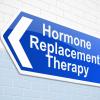CYBERMED LIFE - ORGANIC & NATURAL LIVING
CYBERMED LIFE - ORGANIC & NATURAL LIVING
 Hormone replacement therapy (HRT) is any form of hormone therapy wherein the patient, in the course of medical treatment, receives hormones, either to supplement a lack of naturally occurring hormones or to substitute other hormones for naturally occurring hormones. Common forms of HRT include:
Hormone replacement therapy (HRT) is any form of hormone therapy wherein the patient, in the course of medical treatment, receives hormones, either to supplement a lack of naturally occurring hormones or to substitute other hormones for naturally occurring hormones. Common forms of HRT include:
Androgen replacement therapy (andropausal and ergogenic use) is a hormone treatment often prescribed to counter the effects of male hypogonadism or the "andropause". It is also prescribed to lessen the effects or delay the onset of normal male aging. Additionally, androgen replacement therapy is used for men who have lost their testicular function to disease, cancer, or other causes.
As recently as 2005, women have had a positive attitude towards HRT, but based on the empirical data, these attitudes may be overly optimistic. There is still much to learn about how HRT affects people. In the combined hormone trial, the WHI tested only one estrogen (Premarin) and one progestin (Provera), in a single pill (Prempro), at a single dose (0.625 mg Premarin and 2.5 mg Provera). Therefore, the results are not reliable nor representative.
To avoid HRT risks, it is essential to use the most effective delivery method of both estrogen and progesterone. Bioidentical estradiol (estrogen) when taken orally is converted in the liver to estrone, a weaker bioidentical estrogen. However, when estrogen as estradiol is used transdermally as a patch, gel, or pessary, it enters the bloodstream as bioidentical estradiol. When estrogen is ingested it is subjected to first pass metabolism (Phase I drug metabolism) and is processed through the liver. This first pass metabolism stimulates proteins associated with heart disease and stroke, such as C-reactive protein, activated protein C, and clotting factors. Using a patch, gel, or pessary to take estrogen avoids first pass metabolism and the risks associated with it and the same level of blood concentration can be achieved avoiding the serious side effects associated with oral estradiol HRT. Current research shows that the transdermal route of estradiol administration can also be advantageous for women with diabetes, hypertension and other cardiovascular risk factors, as those risks increase with advancing age. Women taking bioidentical estrogen, orally or transdermally, who have a uterus should still take a progesterone to lower the risk of endometrial cancer. The plant-derived progesterone creams sold over the counter contain too little progesterone to be effective. Wild yam extract creams are not effective since the natural progesterone present in the extract is not bioavailable.
Past research has highlighted potential risks of HRT. The principal results from the Women's Health Initiative Randomized Controlled Trial was that hazard rate of invasive breast cancer exceeded the stopping boundary for this adverse effect and the global index statistic supported risks exceeding benefits.
A study where women going through menopause using HRT with Progestin as a major component of the therapy showed a few adverse effects on hearing, which highlights the importance of choosing bioidentical progesterone instead of synthetic progestin. Not only does the Progestin decrease the functionality of many regions of the ear it also reduces the effectiveness in parts of the central nervous system used for hearing. Also, in some situations, it has been shown that menopausal women who are caregivers and receive HRT can have an increased chance for cardiovascular issues. As caregivers, it is implied that they have more acute stress in their lives and that acute stress along with the HRT is priming negative cardiovascular effects.
Recent research done by the Million Women Study, funded by Cancer Research UK has proven that certain forms of HRT increase the risk of endometrial (womb) cancer. However, previous research has shown that the combined type of HRT poses a greater breast cancer risk than tibolone or oestrogen (estradiol)-only HRT and, because breast cancer is more common than endometrial cancer, the researchers believe that when considering the overall effect of HRT it is important to look at both breast and endometrial cancer. However, this study was conducted using oral estradiol instead of transdermal estradiol which avoids the risks which the study highlights. Again, this shows that the combined estrogen patch (such as Evorel® Conti) or gel (ESTROGEL PROPAK™ - 17ß-estradiol and micronized progesterone) is the preferable treatment choice.
The Society of Obstetricians and Gynaecologists of Canada recommends Transdermal Estrogen and Micronized Progesterone as a first line hormone therapy option stating that the overall benefits of this therapy include reduction of vasomotor symptoms (hot flashes), lower risk of osteoporotic fractures, lessening of urogenital atrophy, lowering somatic pain and arthralgia, lowering the risk of colorectal cancer and mood stabilization.
There is a structural difference between hormone therapies that are bioidentical and those that are non-bioidentical, as non-bioidentical are responsible for side effects and health risks in humans. However, they can have positive health benefits for women, and bioidentical hormones can be customized from individual to individual.
HRT has been shown to have other beneficial effects. In a study women taking estrogen through HRT showed that the estrogen positively affects the prefrontal cortex by boosting the working memory. This suggests that estrogen may play a key role in certain frontal lobe functions in women. Women using HRT after menopause have no additional weight gain compared to women who do not use HRT. Also women who use HRT with an estrogen component show positive effects in their sex life (mainly increasing their libido and sexual sensitivity) but the effects are inconsistent across women. These sexual improvements may dissipate after receiving some forms of HRT for extended periods of time.